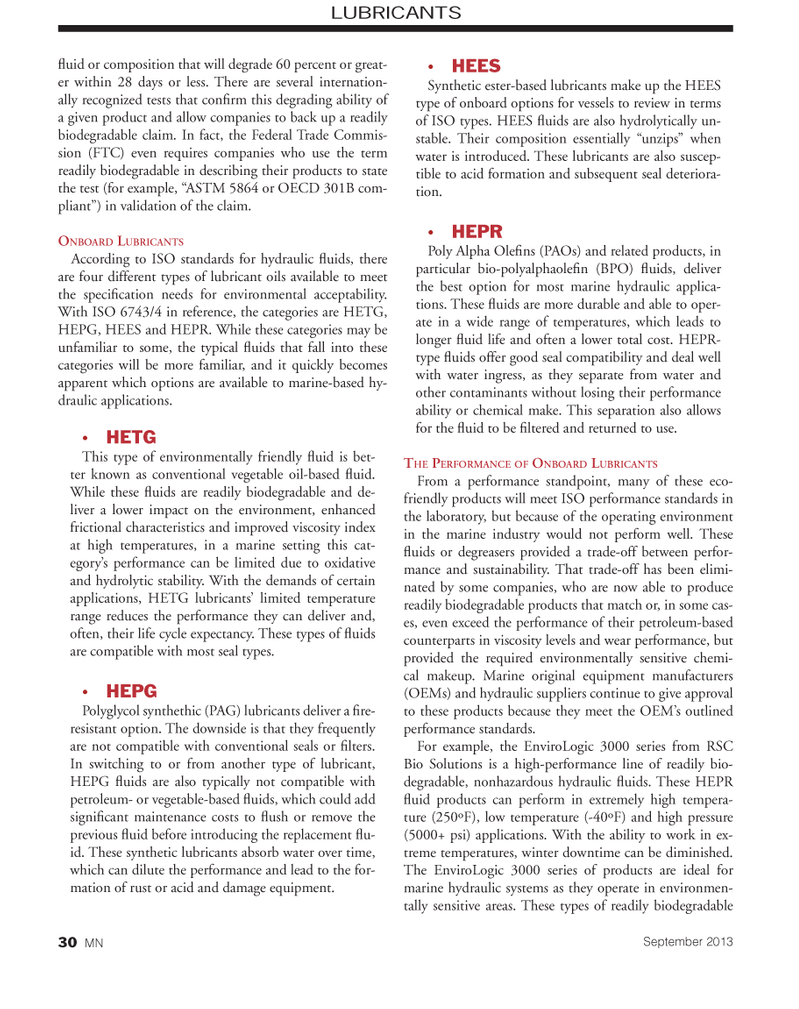
Page 30: of Marine News Magazine (September 2013)
Workboat Annual
Read this page in Pdf, Flash or Html5 edition of September 2013 Marine News Magazine
? uid or composition that will degrade 60 percent or great- er within 28 days or less. There are several internation- ally recognized tests that con? rm this degrading ability of a given product and allow companies to back up a readily biodegradable claim. In fact, the Federal Trade Commis- sion (FTC) even requires companies who use the term readily biodegradable in describing their products to state the test (for example, ASTM 5864 or OECD 301B com- pliant?) in validation of the claim. ONBOARD LUBRICANTS According to ISO standards for hydraulic ? uids, there are four different types of lubricant oils available to meet the speci? cation needs for environmental acceptability. With ISO 6743/4 in reference, the categories are HETG, HEPG, HEES and HEPR. While these categories may be unfamiliar to some, the typical ? uids that fall into these categories will be more familiar, and it quickly becomes apparent which options are available to marine-based hy- draulic applications.? HETGThis type of environmentally friendly ? uid is bet- ter known as conventional vegetable oil-based ? uid. While these ? uids are readily biodegradable and de- liver a lower impact on the environment, enhanced frictional characteristics and improved viscosity index at high temperatures, in a marine setting this cat- egorys performance can be limited due to oxidative and hydrolytic stability. With the demands of certain applications, HETG lubricants limited temperature range reduces the performance they can deliver and, often, their life cycle expectancy. These types of ? uids are compatible with most seal types. ? HEPGPolyglycol synthethic (PAG) lubricants deliver a ? re- resistant option. The downside is that they frequently are not compatible with conventional seals or ? lters. In switching to or from another type of lubricant, HEPG ? uids are also typically not compatible with petroleum- or vegetable-based ? uids, which could add signi? cant maintenance costs to ? ush or remove the previous ? uid before introducing the replacement ? u- id. These synthetic lubricants absorb water over time, which can dilute the performance and lead to the for- mation of rust or acid and damage equipment. ? HEESSynthetic ester-based lubricants make up the HEES type of onboard options for vessels to review in terms of ISO types. HEES ? uids are also hydrolytically un- stable. Their composition essentially unzips? when water is introduced. These lubricants are also suscep- tible to acid formation and subsequent seal deteriora-tion.? HEPRPoly Alpha Ole? ns (PAOs) and related products, in particular bio-polyalphaole? n (BPO) ? uids, deliver the best option for most marine hydraulic applica- tions. These ? uids are more durable and able to oper- ate in a wide range of temperatures, which leads to longer ? uid life and often a lower total cost. HEPR- type ? uids offer good seal compatibility and deal well with water ingress, as they separate from water and other contaminants without losing their performance ability or chemical make. This separation also allows for the ? uid to be ? ltered and returned to use. THE PERFORMANCE OF ONBOARD LUBRICANTS From a performance standpoint, many of these eco- friendly products will meet ISO performance standards in the laboratory, but because of the operating environment in the marine industry would not perform well. These ? uids or degreasers provided a trade-off between perfor- mance and sustainability. That trade-off has been elimi- nated by some companies, who are now able to produce readily biodegradable products that match or, in some cas- es, even exceed the performance of their petroleum-based counterparts in viscosity levels and wear performance, but provided the required environmentally sensitive chemi- cal makeup. Marine original equipment manufacturers (OEMs) and hydraulic suppliers continue to give approval to these products because they meet the OEMs outlined performance standards. For example, the EnviroLogic 3000 series from RSC Bio Solutions is a high-performance line of readily bio- degradable, nonhazardous hydraulic ? uids. These HEPR ? uid products can perform in extremely high tempera- ture (250ºF), low temperature (-40ºF) and high pressure (5000+ psi) applications. With the ability to work in ex- treme temperatures, winter downtime can be diminished. The EnviroLogic 3000 series of products are ideal for marine hydraulic systems as they operate in environmen- tally sensitive areas. These types of readily biodegradable LUBRICANTSSeptember 201330 MNMN Sept2013 Layout 18-31.indd 308/29/2013 11:16:48 AM

 29
29

 31
31
